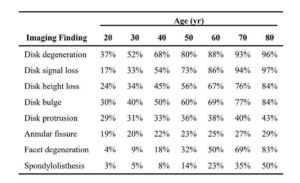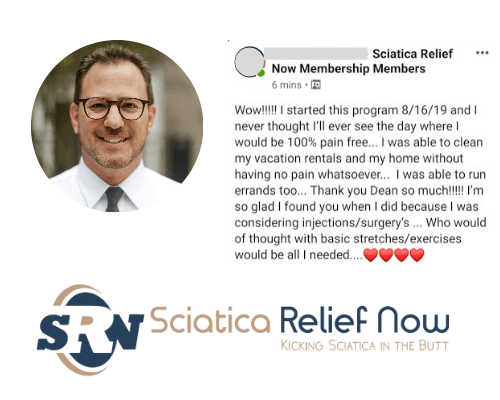Degenerative disc disease is a term that can strike fear into the hearts of many people suffering from back pain and sciatica. However, it doesn’t necessarily have to be that way. Today, we are going to discuss degenerative disc disease, what causes it and what can be done to help it.
Before we dive in, please be aware that we are part of the Amazon Affiliate programme. This page may contain Amazon affiliate links, so if you choose to purchase a product for your sciatica that we recommend through a link on this page, we will receive a small commission at no extra cost to you. This helps us keep Overcome Sciatica alive! Thank you for your support. Please be assured that we only ever recommend products that we truly believe can help.
What is Degenerative Disc Disease?
Degenerative disc disease (or DDD) is basically a fancy term for the wear and tear that occurs in our intervertebral discs as we age. Sometimes called “spondylosis”, DDD generally means a thinning of the discs as they lose water.
In DDD, there may also be tiny tears and breaks present in the intervertebral discs, which can cause further deterioration to the health of a disc.
In some (but not all), DDD can lead to stiffness, back pain and sciatica.
What Happens After a Diagnosis of Degenerative Disc Disease?
Although receiving a diagnosis of degenerative disc disease can be terrifying for any person, it is actually more common than most of us think.
And when I say common, I mean VERY common. In fact, the latest research shows that 68% of people over 40 years of age suffer from some degree of degenerative disc disease!
Oh, and I should mention one thing; the people in this study were ASYMPTOMATIC!
This means that they DIDN’T have back pain, sciatica or painful stiffness.
When the researchers looked at people over the age of 60, they found that 88% of people in their cohort suffered from some degree of DDD, while almost all of their participants over 80 years old showed DDD on an MRI scan.
Here are the full findings of this study:

This is a fascinating study as it shows that DDD may not actually be the direct cause of back pain.
So, when you look at it in this way, degenerative disc disease isn’t really a “disease” at all – just an extremely common part of the aging process.
What About When DDD IS Painful?
There are instances when DDD causes sciatica, however, and this is often because the degenerative discs have thinned in a way that causes a compression of a nerve root within the spine. This irritates the nerve root and causes pain along the course of the nerve.
This irritation around a nerve root causes what we call an “inflammatory response” in that area, and lots of irritating chemicals are released around the affected nerve causing significant pain (as anyone suffering from sciatica can tell you).
It is important to note that a “disc bulge” and degenerative disc disease are NOT the same thing; a disc bulge is usually caused by a large tear in a healthy disc, with the bulge directly pressing on the nerve root. The pain from a disc bulge is usually more acute than the pain from degenerative disc disease, but disc bulges often improve within 12 weeks while DDD pain may stay at a constant low-moderate level for a long time.
The following video explains DDD with some handy diagrams and talks about what to expect when living with untreated DDD:
What Makes Degenerative Disc Disease More Likely?
- Manual lifting, especially with poor technique: people who work in manual lifting jobs are more likely to suffer from DDD, simply because they put more stress and strain through their spines over the course of many years. This is even more apparent when their job involves lifting and twisting too; twisting causes “shearing” forces through the disc and this can accelerate the degenerative process.
- Car accidents: sudden jolts caused by road traffic collisions can rapidly accelerate the process of wear and tear to a disc in the lower back (and neck, of course).
- Poor diet: poor nutrition has been shown to accelerate the aging process throughout the entire body, and one of the areas that this is seen most clearly is in the health of a disc. Eating sugary, fatty foods on a regular basis can certainly begin, and worsen, degenerative disc disease. Eat these better foods in order to reduce inflammation!
- Being overweight: due to the shear compressive force that excess weight has on a person’s spine, being overweight can rapidly accelerate DDD and cause normal, non-symptomatic DDD to cause painful problems. The plus side of this, however, is that a lot of overweight people I have worked with have actually had their sciatica symptoms disappear, simply by dropping some weight! Often, as little as a 4lb loss of weight equates to a noticeable decrease in pain. I wrote a guide specifically for people with sciatica who want to lose weight HERE.
- Age: of course, age is the largest predictor of DDD, with a positive correlation between increasing age and increasing disc height loss. However, aging does NOT need to be a painful process providing you make the right decisions and look after your body!
- Smoking and drinking: cigarettes and alcohol have a pro-inflammatory effect within the body; exactly what we DON’T want for someone suffering from sciatica. The chemicals released from these bad habits will also accelerate the process of disc deterioration.
So, What Can We Do About Degenerative Disc Disease?
First, it is important to realise that while the process of disc degeneration cannot be reversed, the symptoms have potential to be greatly improved!
Let me tell you about one client I had 2 years ago who achieved astounding benefits from the simplest of treatments for DDD.
He was a gentleman in his 40’s who had suffered with back pain (and gradually worsening sciatica) for the last 10 years. He was a ground worker by trade and had never had any manual lifting training, meaning that he was lifting and swinging a hammer with the WORST possible technique, for over 20 years.
When he came to see me, he was unable to work, in significant distress, and had just had an MRI performed on his lower back – the results came back as degenerative disc disease.
Having never had treatment before, he was of course sceptical of my natural approach and suggestions that he may be able to improve his symptoms WITHOUT needing to go under the knife – he genuinely believed he was a lost cause and would need surgery.
Unsurprisingly, when I assessed him, his back was incredibly stiff. He struggled to bend forward more than a few inches.
The work that I asked him to do to treat his DDD worked around the premise of needing to increase the range of motion in his lower back. Once the range of motion increases, so will the mobility of the joints and nerves within the spine, and these structures will then become LESS irritated and move in a MORE natural way. As a consequence of all this, pain almost always reduces, too.
How Did it Work?
I started him off very slowly – with just some very basic lower back flexion exercises. We chose flexion because that was the MOST COMFORTABLE movement for him (i.e. it caused him the least pain). He went home and practiced this movement, flexing forward barely 6 inches, then returning to the start, over and over. He repeated this until the first sign of pain, then he stopped and returned to it later that day.

This is one of the processes I talk through in more detail in my eBook, The 7 Steps to Overcome Sciatica. It is one of my most simple yet effective treatment techniques (which you can try at home too!)
He came back to see me in 2 weeks time, smiling from ear to ear – his symptoms had reduced by 40-50% for the first time in years.
Together, we continued working in this way, along with some nerve flossing exercises to help the affected nerve move better within the spine and legs, too.
Overall, his improvement was enough to get him back to work within 12 weeks – an outcome that he hadn’t expected and a relief to his entire family.
How Do I Put This Into Action?
The exercises provided on this page for informational purposes only and are not designed to be a ‘prescription’ of any kind. Be sure to check with your healthcare provider before you begin any new exercise programme.
Mobilise Your Back in a Pain-Free Way
Try this exercise for yourself: The premise of the treatment is simple – find a movement involving your lower back which is non-painful, even if it is leaning forward or to the side 6 inches.
Stick with that movement and repeat it between 5-10 times, stopping at the first signs of any pain.
Repeat this process every few hours if you can. Make a note of how your range of comfortable movement changes over the course of a week or two.
Are You Looking for RAPID Relief from Sciatica?
My good friend, colleague and fellow international sciatica expert, Dean Volk, has a brand new sciatica relief video course available – and I’m delighted to be an official sponsor!
Check out Dean Volk’s “Kicking Sciatica OUT of the Butt!” Online Pain Relief Course Here!
I can proudly recommend Dean and his course for sciatica sufferers – because I’ve seen his incredible results first-hand. You can check out his course (and get lifetime access to the videos and bonus content) by clicking HERE.
Heat Therapy
Try using heat on the affected area – using a hot compress to the painful area on your back or legs can soothe tight and tense muscles that are clinging on for dear life to protect your back! Don’t neglect the other side either – by treating the GOOD side too, you will help re-balance the imbalances caused by long-term pain.
Mobilise the Nerve
Try nerve flossing exercises, like the ones in this article HERE.
Keep Active and Mobile – and FIX Your diet!
General activity, mobility and the food you put in your mouth can all have a huge positive (or negative) effect on DDD. If you’ve followed my work for any length of time, you’ll know that I am heavily into recommending entire health transformations for anyone suffering from back pain or sciatica, and DDD is no different!
Summary
I hope this article has been useful for you if you are currently worried about or suffering from degenerative disc disease.
What have your experience with DDD been like? Have you found anything that has helped you?
Leave a comment below to share your story with our community!
The information on Overcome Sciatica should never be used as a substitute for medical advice from a doctor. Never put into action any tips or techniques from Overcome Sciatica without checking with your doctor first. Please see full terms of use here.


